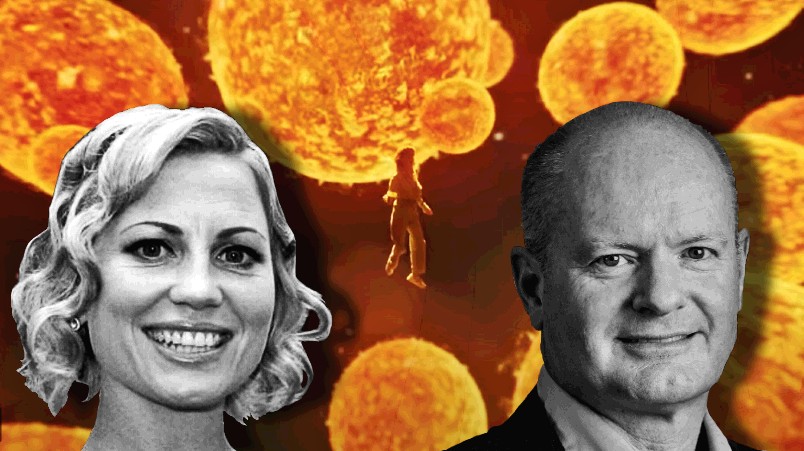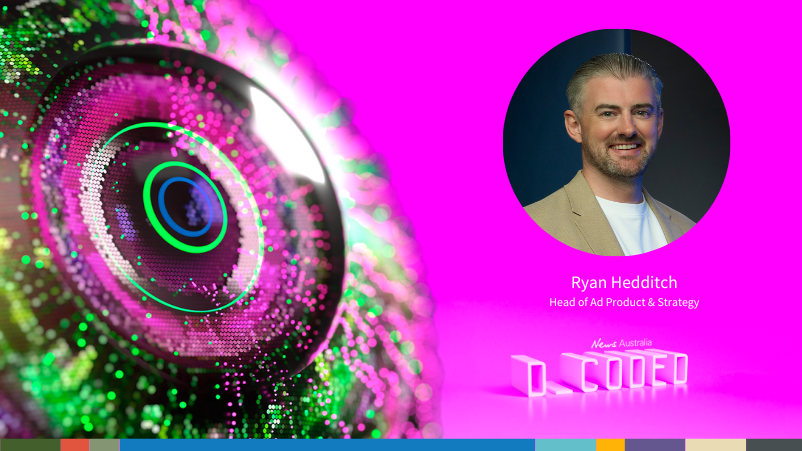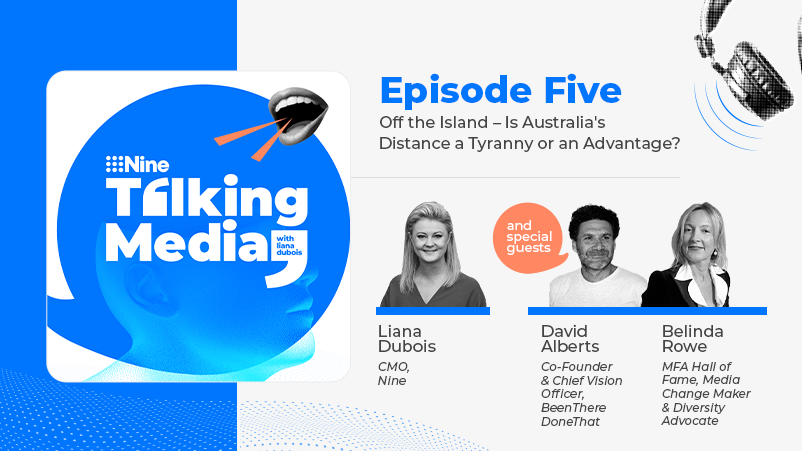Brand acrobatics: Adobe wrestles with ‘category awareness’ for CX as LinkedIn signals B2B CMOs prime 2024 budgets, CFOs greenlight creative spend – MYOB, Canva, MailChimp advance

B2B creative that ignites growth potential with the power of a thousand suns? LinkedIn's Mel Furze reckons MYOB's latest campaign sets the B2B standard. Adobe's Duncan Egan is laying the ground for a 'double duty' CX brand offensive.
It’s taken a couple of years, but the LinkedIn-backed B2B Institute’s mission to flip business-to-business marketing’s focus from performance to brand building – encapsulated by the Ehrenberg-Bass Institute penned 95:5 rule – is starting to land, crucially in the boardroom and exec leadership echelons. LinkedIn’s polling of B2B CMOs and CFOs suggests most are planning to spend more on brand this year and are beginning to grasp that rational, product-focused messaging doesn’t cut it. The likes of MYOB, Canva and MailChimp are setting the creative standard, reckons LinkedIn’s Global VP of Customer Science and B2B Institute Global Head, Melissa Furze. But there’s still a long way to go, as Adobe’s APAC and Japan VP of Digital Experience Marketing, Duncan Egan will attest. Adobe, he admits, is challenged with brand awareness – or more accurately, category awareness, when it comes to being known as a CX company versus its Photoshop legacy. He’s hoping to change that with a full-funnel push – and convince the sales-focused short-termists that brand both fuels demand and ultimately speeds conversion.
What you need to know:
- CMOs expect to increase marketing budgets in 2024 per LinkedIn data, including a survey of 46 CMOs, 62 senior marketers and 42 CFOs at Australian B2B firms.
- Crucially, CFOs are greenlighting a greater slice of those budgets to drive longer-term growth, according to LinkedIn’s Global VP of Customer Science and B2B Institute Global Head, Melissa Furze.
- Adobe’s VP of Digital Experience Marketing across APAC and Japan, Duncan Egan, has been running pilots in a bid to build the business case for increased brand spending across the region.
- While Adobe has a very strong brand, he says it has a category awareness problem, particularly in APAC: Everybody knows Adobe for Photoshop and Acrobat, less so for its CX suite.
- Egan’s hoping to convince the broader organisation that building that awareness will bring people through the funnel and ultimately ease conversion, not just gobble up pipeline budgets. “Where the rubber hits the road is how much [budget] we are going to dedicate to it,” he admits.
- Either way, LinkedIn’s Furze thinks the message that B2B marketing needs to be just as emotional – perhaps more so – than B2C comms and more heavily weighted towards brand than lead gen, per the Ehrenberg-Bass formulated 95:5 rule, is starting to land. She suggests the change in creative approach from the likes of MYOB,Canva and MailChimp are recent proof points.
People don't know us as the customer experience company, they know us as Photoshop, they know us as Acrobat.
“Adobe has a very unique challenge. Our awareness is off the charts – we’re number 17 in the highest value brands globally,” says APAC and Japan VP of Digital Experience Marketing, Duncan Egan. “But people don't know us as the customer experience company, they know us as Photoshop, they know us as Acrobat. So our opportunity, particularly in the enterprise B2B side, is to really educate at a category awareness level that we sell products across the entire funnel from websites to analytics to journey orchestration to targeting.”
Egan says Adobe’s executive team “do understand” the need to invest to build out the experience side of Adobe’s brand, “and it will hopefully be sustained,” he adds. But Egan underlines it is a “thoughtful approach”, i.e. blending long and short.
“This is the conversation we’re having now to really get the message out over time,” he says, with more firepower required in some markets than others – namely his patch.
“In North America our brand is better. EMEA is not quite as good, and then Asia Pacific, it’s even less aware, particularly from the customer experience side. So we would look at key markets for us to do some pilots to drive that category awareness branding versus solution branding. They are all doing a positive thing, which is educating either our short-term or future buyers around the value that Adobe digital experience can bring to them.”
Sentiment shift?
Overall, he says, “I fully subscribe to the 95:5 rule. But I do think a lot of companies, when they set their metrics and goals, are thinking about the five,” given the pressure on hitting quarterly sales targets.
But sentiment may be starting to shift.
LinkedIn’s most recent sweep of 2,000 B2B marketers and finance execs – including 46 CMOs, 62 senior marketers and 42 CFOs in Australia – shows “64 per cent expect marketing budgets to grow over the coming year”, per LinkedIn’s Global VP of Customer Science and B2B Institute Global Head, Melissa Furze. Crucially, CFOs are greenlighting a greater slice of those budgets to drive longer-term growth.
“Globally, we see that six in ten B2B marketing leaders say their C-suite has actually increased the importance of brand building, and that’s specifically in light of the economic conditions, because they see this as an avenue to win share,” says Furze. “We also see that reflected in the way that companies are investing in different skills, and different roles, including things like influencer marketing specialists and things like brand marketing consultant.”
Furze suggests the apparent acknowledgement of brand as growth engine hasn’t happened by happy coincidence, but because B2B marketers have pushed themselves upstream – weaning themselves of soft metrics to talk hard business outcomes and re-articulating marketing’s growth remit – in order to reframe the narrative and enable reallocation of resource. Now, instead of focusing investment on the small percentage of potential buyers in market, LinkedIn’s data suggests top brass appear increasingly willing to spend to fill the future demand pipeline.
Where the rubber hits the road is how much are we going to dedicate to it [brand building]. And that is when people get a little more sensitive, ‘hey, you're now taking my pipeline budget away and you're putting it to brand’.
Brand to demand
For all the head nodding around the 95:5 concept (which states only around 5 per cent of customers are in market at any one time. The remaining 95 per cent aren’t buying, so marketers should prime them with memorable brand ads in order to be in mind when they do come to market instead of smashing them with so-called performance ads), the question is how much money will B2B brands actually reallocate from performance or short-term marketing into longer-term brand building?
Adobe, Egan suggests, is working through that process having run a series of “brand to demand” pilot campaigns that tracked how people were responding and engaging with brand messaging, coming to its sites and poking around its content, through to lead capture, i.e. signing up for “a webinar on analytics”.
“Tying those two [ends] together gives us credibility with the e-team [executive team] that we are leveraging the expertise we have in the data, the perspective of our customers, our funnels and what we're doing. Then being able to link that through our web and our engagement with our customers, from an awareness perspective, has really given us the credibility to do these pilots and give tangible data on the impact that it's had – and also a set us up very well going into this year around what we're going to be doing and how we're going to be expanding that,” says Egan.
“Where the rubber hits the road is how much are we going to dedicate to it. And that is when people get a little more sensitive, ‘hey, you're now taking my pipeline budget away and you're putting it to brand’. But our opportunity is ‘no, you're actually going to increase the impact in the long term with our customers or potential customers, because they will understand the value we bring to them’,” Egan suggests. “And I think a lot of b2b companies are thinking the same way around that: If I don’t have to explain what we do, we are four steps down that road to having a productive conversation.”
Once you spend your media budget – it’s simply gone. Whereas with great creative, it's a more durable investment. It can be used and reused, ultimately extending the life of your creative assets – and it can generate long-lasting growth.
Cut crap creative, cut through
Furze says the likes of MYOB, Canva and MailChimp are nailing it when it comes to both brand investment and execution. She also shamelessly plugs LinkedIn’s latest B2B brand campaign – ‘no one knows what you do’.
“The campaign really highlights that if you're a B2B marketer, it feels like no one knows what you do. Your parents, your loved ones, your friends really don't get it. But while not everyone gets B2B, LinkedIn hits the decision-makers who do and has the tools that can help you reach them,” says Furze.
“So it's a it's a departure for us. It's a tongue in cheek advertising campaign backed around emotion that we believe is so important in advertising for B2B. We did it in partnership with Ryan Reynolds’ agency Maximum Effort and we're really proud of it.
Plus, LinkedIn probably has more money to spend on marketing to drive future demand in 2024 than it did in 2023. Ad revenues have soared at the platform over the last 12 months as advertisers flee X for the safe harbour of the Microsoft-owned platform and its rich B2B and jobs data.
Furze claims LinkedIn is “drinking its own champagne on best practice” when it comes to investing in emotionally-driven creative. The B2B Institute’s own research has found that, barring brand size and market share, creative execution is the single biggest factor in determining whether advertising moves the needle. Moreover, its study of 600 B2B ads found that 71 per cent were likely to generate zero sales because they are boring, formulaic, under-branded and have brand calls in the wrong places. Derek Yueh, Partnership Lead at the B2B Institute, advised B2B marketers to forget voiceovers and heavy text and start concentrating on story arcs, characters and everyday settings – while packing in brand cues early and often.
MYOB appears to have taken some of that advice onboard. The Australian-founded accounting software firm, now owned by private equity giant KKR, went heavy on story and humour in its brand campaign launched at the start of last year to create an ad that’s a little less vanilla than its earlier efforts.
Furze is a fan of the Howatson+Co delivered ad.
“MYOB’s goal was to reshape how businesses of all sizes across ANZ perceive their brand, which is a 30 year old brand, and in turn, become the leading name in business management software.”
The resulting MYOBelive campaign, reckons Furze, is a standout example “of how b2b brands can deploy compelling creative and get away from the shackles of what we traditionally see in b2b creative – which is more or product-lead, feature-based rational messaging … It’s certainly more of a human-centered and emotionally-led campaign [that uses] some hyper creative, wacky videos that really break down the complexity of MYOB’s products. So we really believe its new content strategy shows a lot of ingenuity and creativity.”
Ultimately, suggests Furze, investing in great creative drives sales. “We see in some studies [such as this Ehrenberg-Bass Institute paper] that it can generate 10-20 times more sales compared to poor creative. So we really believe that in B2B, that is where the opportunity lies,” she says.
“Great creative is not just about memorability, it's actually compelling business investment. If you think about it, while media investments are key, once you spend your media budget – it’s simply gone. Whereas with great creative, it's a more durable investment. It can be used and reused, ultimately extending the life of your creative assets – and it can generate long-lasting growth.”
Furze thinks that message is starting to land with B2B marketers. But underlines there is still a long way to go before staid, rational, product-led advertising is entirely jettisoned.
“I'm calling out that this is where the biggest opportunity is. There has been a belief for many years that b2b buyers think about purchases in very rational ways. Whereas if you think about it, if you're making a b2b purchase decision, it actually requires even more emotion than a B2C purchase that you're making for yourself. Because you're making it on behalf of your company, your employees, it'll be a product that your stakeholders assess, that your colleagues will use and leverage – and so it actually requires even more emotional investment.”
Generative AI
Generative AI is unlikely to replace top grade creativity any time soon. But Adobe’s Duncan Egan thinks it’s going to be “game changing” in terms of efficiencies further down the food chain.
“If you think about the volume of work that we as b2b marketers do, whether it's webinars, emails, white papers, you name it, there's a lot of creative and quite frankly, content that needs to be delivered in an impactful way.” Which is where generative AI can do much of the grunt work around templating, resizing, translating and optimisation, freeing up time and “enabling the role of the marketer to expand”, per Egan.
Other big B2B firms are plotting similar paths, with the likes of Salesforce automating jobs that were never marketing in the first place, according to APAC CMO, Leandro Perez. LinkedIn’s Furze suggests that will rapidly become the norm.
“Our data shows that eight in 10 B2B leaders plan to increase their use of generative AI in the coming year,” she says, with LinkedIn ramping up its AI-powered tools, hence launching “AI-generated copy tools” last year (though not everybody is a fan, with ‘virtual professor’ Mark Ritson questioning the product team’s logic).
Either way, Adobe’s Egan says it is now incumbent on B2B – and B2C – firms to upskill teams on the latest technology, especially AI, which he calls out as a key priority for 2024. “We need to get comfortable with it, because it is coming. Arguably it is here.”



